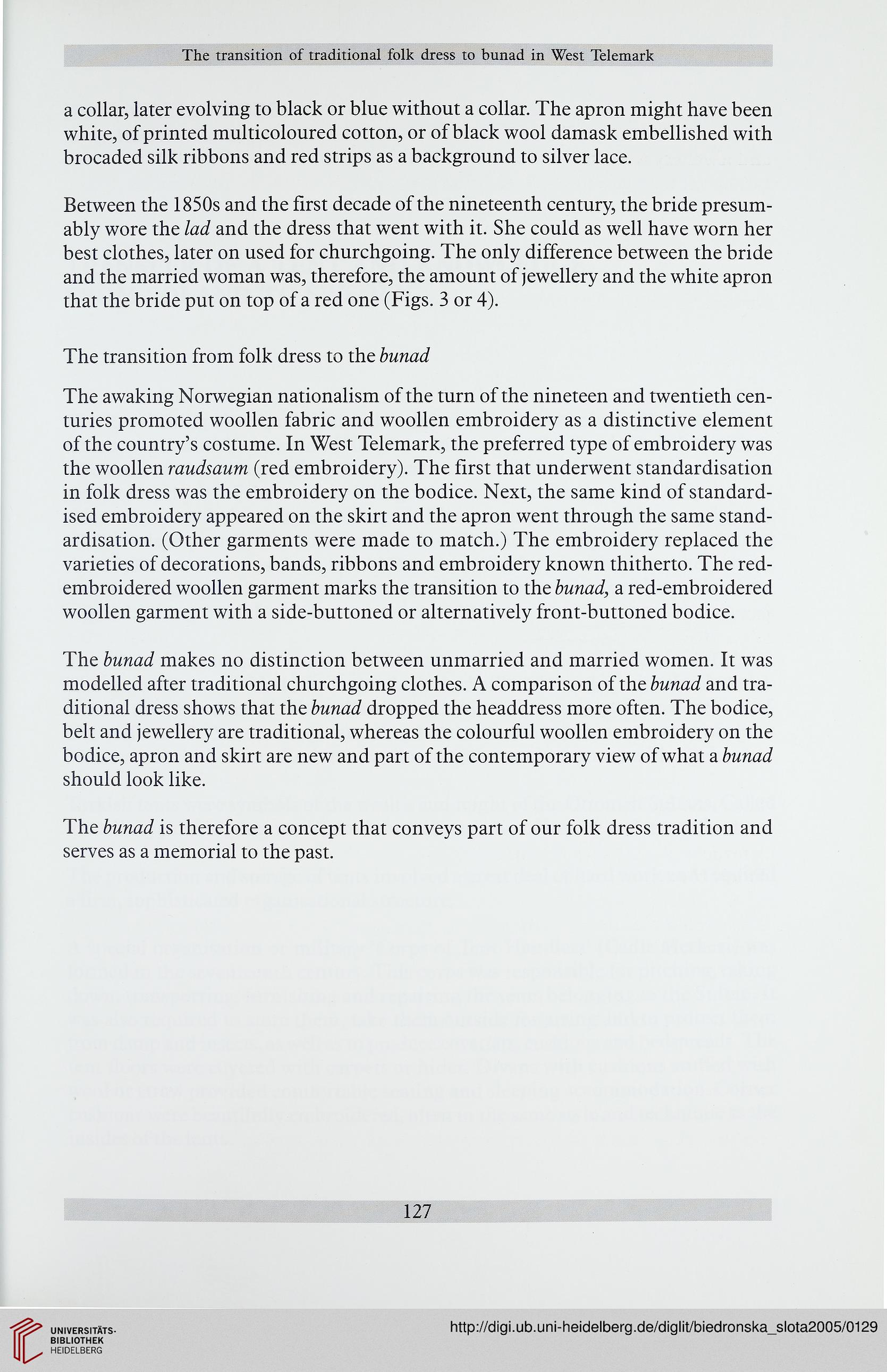The transition of traditional folk dress to bunad in West Telemark
a collar, later evolving to black or blue without a collar. The apron might have been
white, of printed multicoloured cotton, or of black wool damask embellished with
brocaded silk ribbons and red strips as a background to silver lace.
Between the 1850s and the first decade of the nineteenth century, the bride presum-
ably wore the lad and the dress that went with it. She could as well have worn her
best clothes, later on used for churchgoing. The only difference between the bride
and the married woman was, therefore, the amount of jewellery and the white apron
that the bride put on top of a red one (Figs. 3 or 4).
The transition from folk dress to the bunad
The awaking Norwegian nationalism of the turn of the nineteen and twentieth cen-
turies promoted woollen fabric and woollen embroidery as a distinctive element
of the country's costume. In West Telemark, the preferred type of embroidery was
the woollen raudsaum (red embroidery). The first that underwent standardisation
in folk dress was the embroidery on the bodice. Next, the same kind of standard-
ised embroidery appeared on the skirt and the apron went through the same stand-
ardisation. (Other garments were made to match.) The embroidery replaced the
varieties of decorations, bands, ribbons and embroidery known thitherto. The red-
embroidered woollen garment marks the transition to the bunad, a red-embroidered
woollen garment with a side-buttoned or alternatively front-buttoned bodice.
The bunad makes no distinction between unmarried and married women. It was
modelled after traditional churchgoing clothes. A comparison of the bunad and tra-
ditional dress shows that the bunad dropped the headdress more often. The bodice,
belt and jewellery are traditional, whereas the colourful woollen embroidery on the
bodice, apron and skirt are new and part of the contemporary view of what a bunad
should look like.
The bunad is therefore a concept that conveys part of our folk dress tradition and
serves as a memoriał to the past.
127
a collar, later evolving to black or blue without a collar. The apron might have been
white, of printed multicoloured cotton, or of black wool damask embellished with
brocaded silk ribbons and red strips as a background to silver lace.
Between the 1850s and the first decade of the nineteenth century, the bride presum-
ably wore the lad and the dress that went with it. She could as well have worn her
best clothes, later on used for churchgoing. The only difference between the bride
and the married woman was, therefore, the amount of jewellery and the white apron
that the bride put on top of a red one (Figs. 3 or 4).
The transition from folk dress to the bunad
The awaking Norwegian nationalism of the turn of the nineteen and twentieth cen-
turies promoted woollen fabric and woollen embroidery as a distinctive element
of the country's costume. In West Telemark, the preferred type of embroidery was
the woollen raudsaum (red embroidery). The first that underwent standardisation
in folk dress was the embroidery on the bodice. Next, the same kind of standard-
ised embroidery appeared on the skirt and the apron went through the same stand-
ardisation. (Other garments were made to match.) The embroidery replaced the
varieties of decorations, bands, ribbons and embroidery known thitherto. The red-
embroidered woollen garment marks the transition to the bunad, a red-embroidered
woollen garment with a side-buttoned or alternatively front-buttoned bodice.
The bunad makes no distinction between unmarried and married women. It was
modelled after traditional churchgoing clothes. A comparison of the bunad and tra-
ditional dress shows that the bunad dropped the headdress more often. The bodice,
belt and jewellery are traditional, whereas the colourful woollen embroidery on the
bodice, apron and skirt are new and part of the contemporary view of what a bunad
should look like.
The bunad is therefore a concept that conveys part of our folk dress tradition and
serves as a memoriał to the past.
127




